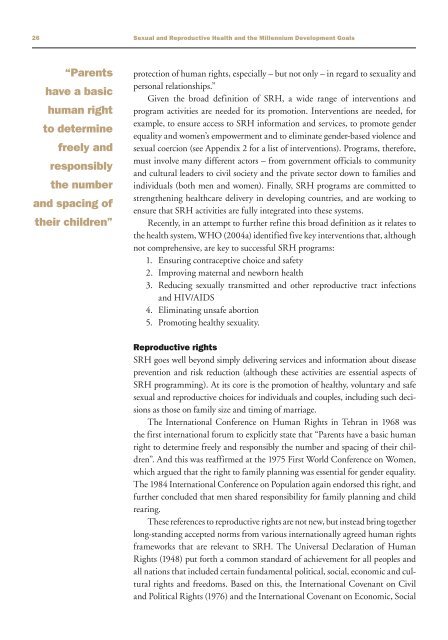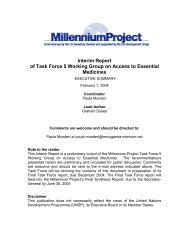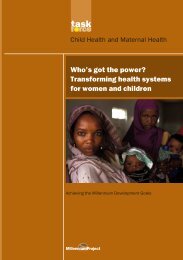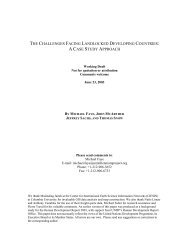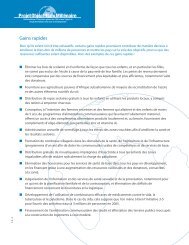Public Choices, Private Decisions: Sexual and Reproductive Health ...
Public Choices, Private Decisions: Sexual and Reproductive Health ...
Public Choices, Private Decisions: Sexual and Reproductive Health ...
Create successful ePaper yourself
Turn your PDF publications into a flip-book with our unique Google optimized e-Paper software.
26 <strong>Sexual</strong> <strong>and</strong> <strong>Reproductive</strong> <strong>Health</strong> <strong>and</strong> the Millennium Development Goals<br />
“Parents<br />
have a basic<br />
human right<br />
to determine<br />
freely <strong>and</strong><br />
responsibly<br />
the number<br />
<strong>and</strong> spacing of<br />
their children”<br />
protection of human rights, especially – but not only – in regard to sexuality <strong>and</strong><br />
personal relationships.”<br />
Given the broad definition of SRH, a wide range of interventions <strong>and</strong><br />
program activities are needed for its promotion. Interventions are needed, for<br />
example, to ensure access to SRH information <strong>and</strong> services, to promote gender<br />
equality <strong>and</strong> women’s empowerment <strong>and</strong> to eliminate gender-based violence <strong>and</strong><br />
sexual coercion (see Appendix 2 for a list of interventions). Programs, therefore,<br />
must involve many different actors – from government officials to community<br />
<strong>and</strong> cultural leaders to civil society <strong>and</strong> the private sector down to families <strong>and</strong><br />
individuals (both men <strong>and</strong> women). Finally, SRH programs are committed to<br />
strengthening healthcare delivery in developing countries, <strong>and</strong> are working to<br />
ensure that SRH activities are fully integrated into these systems.<br />
Recently, in an attempt to further refine this broad definition as it relates to<br />
the health system, WHO (2004a) identified five key interventions that, although<br />
not comprehensive, are key to successful SRH programs:<br />
1. Ensuring contraceptive choice <strong>and</strong> safety<br />
2. Improving maternal <strong>and</strong> newborn health<br />
3. Reducing sexually transmitted <strong>and</strong> other reproductive tract infections<br />
<strong>and</strong> HIV/AIDS<br />
4. Eliminating unsafe abortion<br />
5. Promoting healthy sexuality.<br />
<strong>Reproductive</strong> rights<br />
SRH goes well beyond simply delivering services <strong>and</strong> information about disease<br />
prevention <strong>and</strong> risk reduction (although these activities are essential aspects of<br />
SRH programming). At its core is the promotion of healthy, voluntary <strong>and</strong> safe<br />
sexual <strong>and</strong> reproductive choices for individuals <strong>and</strong> couples, including such decisions<br />
as those on family size <strong>and</strong> timing of marriage.<br />
The International Conference on Human Rights in Tehran in 1968 was<br />
the first international forum to explicitly state that “Parents have a basic human<br />
right to determine freely <strong>and</strong> responsibly the number <strong>and</strong> spacing of their children”.<br />
And this was reaffirmed at the 1975 First World Conference on Women,<br />
which argued that the right to family planning was essential for gender equality.<br />
The 1984 International Conference on Population again endorsed this right, <strong>and</strong><br />
further concluded that men shared responsibility for family planning <strong>and</strong> child<br />
rearing.<br />
These references to reproductive rights are not new, but instead bring together<br />
long-st<strong>and</strong>ing accepted norms from various internationally agreed human rights<br />
frameworks that are relevant to SRH. The Universal Declaration of Human<br />
Rights (1948) put forth a common st<strong>and</strong>ard of achievement for all peoples <strong>and</strong><br />
all nations that included certain fundamental political, social, economic <strong>and</strong> cultural<br />
rights <strong>and</strong> freedoms. Based on this, the International Covenant on Civil<br />
<strong>and</strong> Political Rights (1976) <strong>and</strong> the International Covenant on Economic, Social


